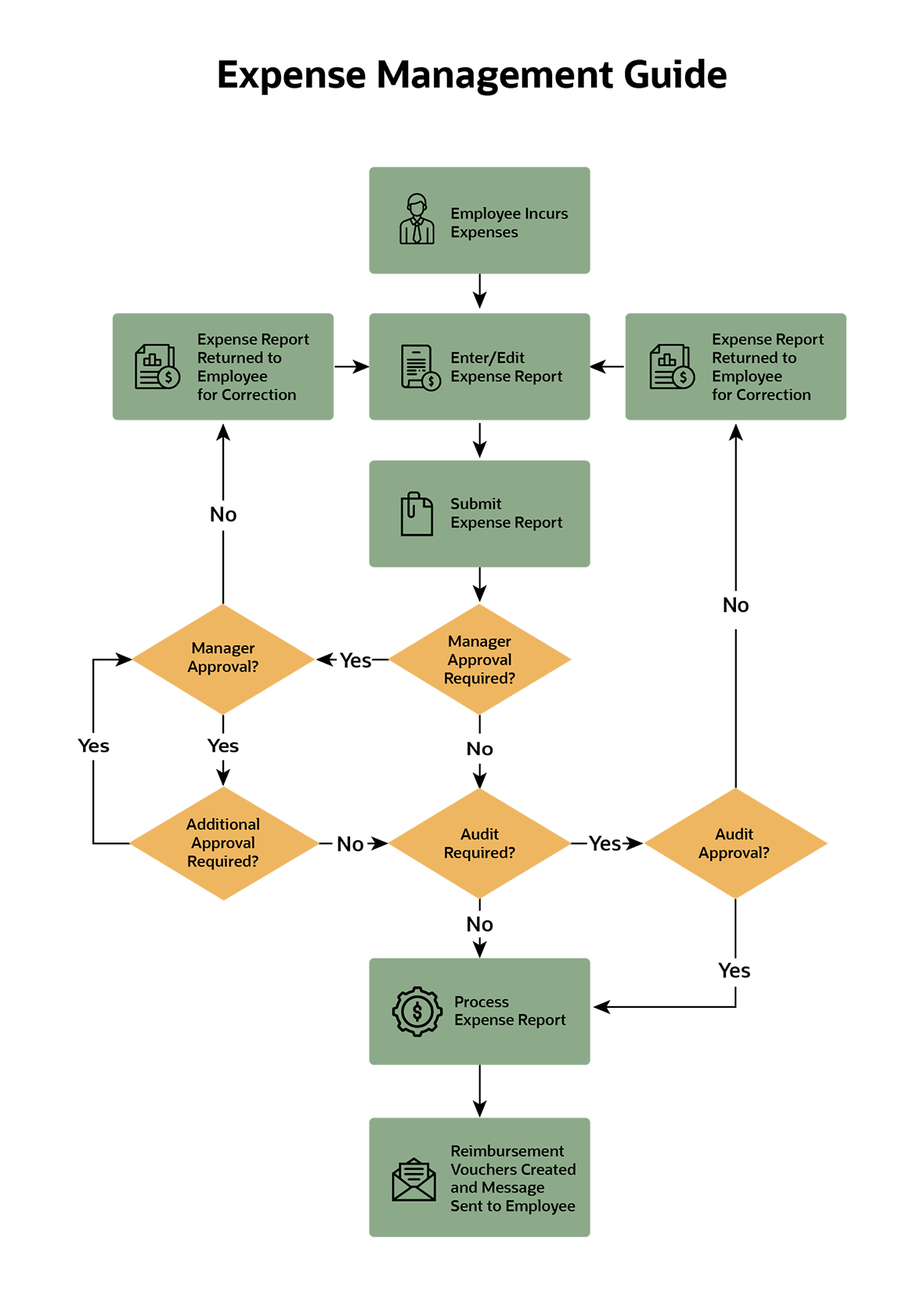Expense management is the process and the policies associated with how an employee is reimbursed for money spent on work-related items.
Business lunches and travel-related outlays most often come to mind when people think about the process of submitting, approving and processing expense reports. Given many of us are not traveling as much for work, and business meetings are largely being held via Zoom, it can be tempting to shelve work on expense management processes and policies for now. But that’s a mistake because there are other major issues around spend and expense management — some of which even arose before the pandemic.
Introduction to Expense Management
This is an excellent time to work on a policy that addresses how your company is working now, and how you expect to do business in the coming year to 18 months.
For example, is your policy clear on whether that ergonomic office chair or Zoom subscription is reimbursable? Does it take into account employee credit cards?

Expense Management vs Spend Management
Is the process by which businesses define policies, enforce them and reimburse employees. Spend management is the discipline of categorising major drivers of spend, discovering whether policies are effective and making changes to ensure that they serve the business well. Better expense management leads to better spend management.
Expense Management Challenges and Costs
Setting a travel and expense budget is a crucial first step to containing what is the second largest indirect expenditure for many organisations, with corporate travel amounting to 21.4% of global business travel in 2018, according to the World Travel and Tourism Council.
Historically, it’s also been one of the expense types most difficult to rein in. A recent study indicates that there are close to 400 fraudulent expense claims made monthly across Singapore, Malaysia, Indonesia and the Philippines. The numbers are no better in the Australian market, with the Australian Tax Office identifying $100 million in false claims in 2017.
While the growth of corporate travel may be slower than expected pre-pandemic, the factors that can make it a challenge to keep under control will still exist. Improper expense claims may be a by-product of an unclear and unrealistic expense policy or a poorly communicated one. Creating a policy that is both thorough and clear is one of the challenges of expense management, but without one, there are cascading repercussions because more time is spent completing, rejecting and processing expense claims.
Expense Management Policy Basics
Employees won’t be able to clearly follow a policy if the policy isn’t clear. Unfortunately, not all companies can get by with Netflix’s well-known (and easy to remember) policy: “Act in Netflix’s best interests.” Most need to devote a lot of ink to define what and how much is reimbursable, the limits by which certain levels of approval are triggered and the basic framework for how expenses are approved and paid.
How to Develop an Expense Management Policy
To build the expense management policy:
-
Define what is covered and, more importantly, what’s not covered — typically airline upgrades, child and pet care, house-sitting, commuting between home and the primary work location, on-demand video in hotel rooms and laundry and dry cleaning (job dependent, of course).
-
Consider all the ways an employee may leverage the expense management policy beyond business travel, such as submitting charges for lower-cost subscription software tools and home office expenses.
-
Decide how much to budget for travel and define limits for reimbursement. On average, a week-long trip to Singapore for one person usually costs au$1,145. For information on average Australian airfares, visit The Bureau of Infrastructure and Transport Research Economics. The ATO (Australia) and the IRD (New Zealand) also provide calculators and information on employee allowances and the average mileage reimbursement rates. Don’t forget to cover the relationship with suppliers and contractors in the expense policy.
How to Update and Evolve the Existing Expense Management Policy
To ensure compliance with the policy, it needs to evolve with the environmental and economic conditions that employees are working under. For instance, at the start of the coronavirus pandemic, Google issued an update to its expense policy that employees couldn’t expense food, office furniture, gym costs or gifts while working from home — even if there was extra money in event and travel budgets that wouldn’t be used. It then announced it would give every employee $1,000 to outfit home offices.
To make decisions like that, companies need visibility into categories of spend and the levers driving it. One best practice is to establish a “Travel and Expense” committee that meets monthly — ideally — and where representatives from several parts of the business, such as corporate communications, finance, human resources, sales and possibly legal, review and update policy as needed.
That group’s charter should also include communication. A standard practice is to have employees sign off that they’ve read the policy during the onboarding process — a time when a huge amount of information is being thrown their way. When it comes time to travel, many employees seek advice from managers who themselves may not be up to speed.
Provide regular, targeted updates to managers, calling out information specifically relevant for their departments, in the form of emails or, in the case of significant updates, a webcast or training session. For messages that need to be read by all employees, distribute a company-wide memo from a senior executive that clearly explains the reasons behind the policy changes, as well as where employees can find updates. Consider making that message personal. The Australian government has published a handy guide to managing change that can be used in any market, which recommends clearly explaining the reasons behind any changes, including calling on past mistakes or highlighting difficult areas and how to avoid them. Finally, publish that memo in an easy-to-access section on the employee intranet page.
Mistakes to Avoid
Even with the best communication, expense management fraud can happen at one time or another in most companies. Within APAC, some 16% of fraud schemes involve expenses, according to The Association of Certified Fraud Examiners,with the average loss for organisations being US$195,000 per annum. Employees may try to pass personal expenses off as business ones. They may inflate expenses, make up expenses or submit the same expense more than once.
One of the biggest mistakes companies make is failing to make it clear that policies apply to everyone. Within APAC, fraud was most frequently (40%) committed by lower-level employees, but the average loss from those instances was ‘only’ US$73,000. For comparison, senior executives were least likely to commit fraud (21%), but the average loss was significantly greater, at US$1.2m. Communicating the importance of adhering to the policy must come from the top down.
Why Use Expense Management Software?
The first-ever expense report, according to the Boston Business Journal, was likely submitted by Paul Revere. Following a series of rides in 1775, Revere submitted a hand-written receipt “to expense for self and horse during that time.”
Have your processes come much farther than that? An Amadeus study finds that over 30% of companies still use manual expense management processes, and of that, 22% are still using spreadsheets, running the risk of costly errors.
Expense management software reduces the time and effort required to submit, approve and process employee expense reports; it also streamlines the process by which employees are reimbursed. It can help track and monitor how much and what employees are asking for reimbursement on and make it easy to break out categories of spend. This helps reduce risk presented by fraudulent expense claims as well as better control spending company wide.
With expense management software, the business builds a database of information to mine for trends. Using this data, companies can quickly adjust expense management policies as the business climate demands.
Does Your Expense Management System Need to be Automated?
Excel is still a big part of expense management for many companies, and the resulting errors are a primary drive for why businesses need to automate their expense management. Employees may submit their expenses on a spreadsheet, email it to someone to review, who emails it to someone on the finance team, who imports it into the financial management system.
As a result, at these companies, expense reporting is an error-prone and inefficient process. Employees may lose or forget to include paper receipts or clearly define an expense. Managers waste time reviewing incomplete reports. Oftentimes, managers rely on the finance team to identify red flags, which wastes their time. And all of it delays the employee’s reimbursement and increases frustration and resentment of the whole process.
The risks of manual approval processes and resultant errors extend beyond costs to the business internally. Businesses that need to be audited — from startups seeking investment capital to publicly listed companies — all demand robust reporting capabilities, and for every business, tax compliance demands receipts are logged and easily accessible. Strong governance provided by automated expense management processes is one of its most important features because their automated controls can stop mistakes and identify potential fraud.
Automated Expense Management Features
The median loss from occupational fraud is higher in smaller organisations than larger ones, with expense reimbursement making up 16% of total fraudulent activity. Building internal competency in this area is crucial for small- and medium-sized businesses, and automating expense management — which is often lower on the list of tasks when most people think of automation — actually has a quick return on investment. Features to look for include:
-
Responsive UI that enables employees to easily track expenses where they most often occur — away from the desktop.
-
Expense receipt management and GPS integration includes features like optical character recognition allow the employee to take a picture of a receipt with a smartphone. The software maps to and automatically populates fields to streamline receipt tracking and report submission. With GPS integration, expense management software can automatically log and submit mileage.
-
Corporate credit card integration eases or eliminates the process of collecting paper receipts from employees as well as the process of reconciliation for the finance team.
-
Customisable business rules streamline submission, approval and payment and flag improper or questionable expenses before they are submitted to the next level for approval.
-
Rule-based controls allow businesses to manage expenses proactively by setting enterprise-wide policies and automating approvals. An auditable history makes it easy to provide auditors with necessary information for SOX compliance.
-
Embedded analytics and dashboards allow businesses to analyse expense report trends, spot policy violations and identify gaps in travel policies and potential areas of noncompliance. By breaking out expenses by category, policy violation type and frequency, businesses can see top spenders, drill downs to review detailed expense receipts and uncover any expense policy violations. Expenses can be analysed across cost centres, employees and associated supervisory hierarchies.
-
Integration with your AP and/or payroll system enables a more seamless transaction-to-reconciliation-to payment process, meaning expense spend can be evaluated as part of the company’s overall finances more easily.
Automated expense management software:
-
Saves time from transaction to reconciliation.
-
Saves money because businesses can easily categorise spend and make adjustments, in real time if necessary.
-
Ensures policy compliance by alerting employees to red flags before expense reports can be submitted and encourages compliance with standards.
-
Ensures regulatory compliance by creating a database of all expense claims and providing easy access to data for internal and external audits.
Improve Expense
Management Efficiency
Choosing the Right Expense Management Software
There are five questions every business should ask in order to make sure it chooses a partner that is right for their employees.
-
Are you a public company or planning to go public? You will need software that has robust functionality for compliance with your market’s financial regulator.
-
Do you operate in multiple countries and currencies? You will need multi-currency and possibly multi-language support.
-
Do you deliver projects to your customers? You will need software that updates projects with expenses for more accurate project costing.
-
Do you need specific configurations or customisations? Look for a mature product and associated partner community to ensure the software works for your unique policy requirements.
-
Will the software scale with your business? Cloud-based software can be easily provisioned to accommodate whatever path your business takes. Companies often outgrow basic products that are limited in their scope, such as handling only receipt tracking. Look for products with functionality that scales as the business grows or changes.









